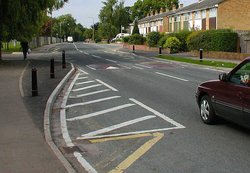Traffic calming
|
|
Street_narrowing.jpg
Traffic calming is a set of strategies used by urban planners and traffic engineers which aims to slow down traffic and improve safety for pedestrians and bicyclists. It is now relatively common in Europe, especially Northern Europe; less so in North America.
Traffic calming has traditionally been justified on the grounds of pedestrian safety and reduction of noise and local air pollution which are side effects of the traffic. However, it has become apparent that streets have many social and recreational functions which are severely impaired by fast car traffic. Donald Appleyard's book Livable Streets quantified these effects. For example, residents of streets with light traffic had, on average, three more friends and twice as many acquaintances as the people on streets with heavy traffic which were otherwise similar in dimensions, income, etc. For much of the twentieth century, streets were designed by engineers who were charged only with ensuring traffic flow and not with fostering the other functions of streets. The rationale for traffic calming is now broadening to include designing for these functions.
Displaced traffic is not totally pushed onto other routes, as some travellers begin to walk or use other modes such as public transit and bicycles to get where they are going.
It should be noted the some of these measures (including speed humps and choke points) have a tendency to irritate and annoy drivers rather than calm them and others (including traffic circles) can actually increase traffic throughput. Some drivers who slow down at calming points, however, accelerate and speed after passing them in order to "catch up for lost time". For this reason, more advanced methods integrated into the design of the street, which make slower speeds seem more natural to drivers and less of an artificial imposition, are now preferred.
There are 3 "E"'s that traffic engineers refer to when discussing traffic calming: engineering, (community) education, and (police) enforcement. Because neighborhood traffic management studies have shown that often it is the residents themselves that are largely contributing to the perceived speeding problem within the neighborhood, it is stressed that the most effective traffic calming plans will entail all three components, and that engineering measures alone will not produce satisfactory results.

Types of traffic-calming engineering measures
Traffic calming can include the following specific engineering measures:
- Narrow streets - existing streets can be narrowed by extending the sidewalk, adding bollards or planters, or adding a bike lane or parking
- Speed humps, sometimes split or offset in the middle to help emergency vehicles reduce delay
- Traffic circles, which are essentially small roundabouts
- Chicanes, which create a horizontal deflection causing vehicles to slow as they would for a curve
- Raised crosswalks and raised intersections
- Curb extensions (also called bulbouts) which narrow the width of the roadway at designated pedestrian crossings
- Pedestrian refuges or small islands in the middle of the street
- Median diverters to prevent left turns or through movements into a residential area
- Changing the surface material or texture (for example, the selective use of brick or cobblestone)
- Additional stop or yield signs
- Converting two-way streets into one-way streets
- Chokers, which are curb extensions that narrow the roadway to a single lane at points
- Allowing parking on one or both sides of a street
- Converting an intersection into a cul-de-sac or dead end
- Closing of streets to create pedestrian zones
- Reducing speed limits near institutions such as schools and hospitals
- Speed feedback signs and "Slow down" warning signs that alert a driver when they exceed the speed limit.
Living street
A living street (or woonerf) is a street in which the needs of car drivers are secondary to the needs of users of the street as a whole; traffic calming principles are integrated into their design.
External links
- Donald Appleyard's Livable Streets study (http://www.pps.org/info/placemakingtools/placemakers/dappleyard)
- Overview from the city of Portland, Oregon (http://www.trans.ci.portland.or.us/trafficcalming/devices/devices.htm)
- Online Transportation Demand Management Encyclopedia (http://www.vtpi.org/tdm/)
- TrafficCalming.org - A Practical Guide to Traffic Calming (http://www.trafficcalming.org)
